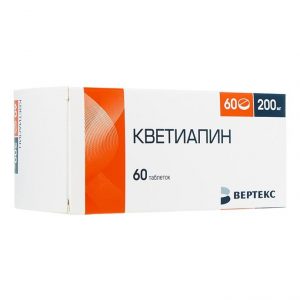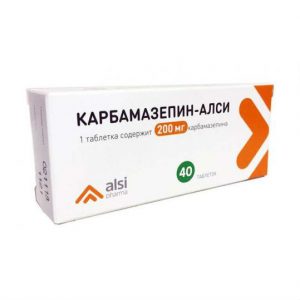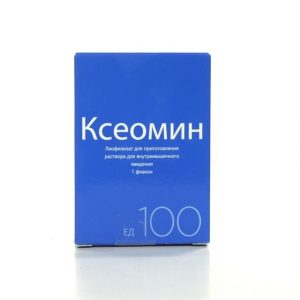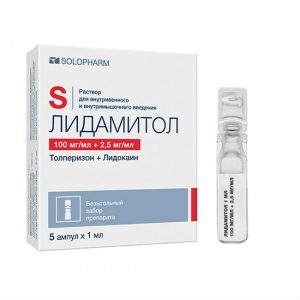Description
Pharmacological action
Pharmacological action – neurometabolic, nootropic.
Pharmacodynamics
Derived adamantane. It is a non-competitive antagonist of N-methyl-D-aspartate (NMDA) receptors, has a modulating effect on the glutamatergic system. Regulates ion transport, blocks calcium channels, normalizes membrane potential, improves the transmission of nerve impulses. Improves cognitive processes, increases daily activity.
Pharmacokinetics
Absorption. Quickly and completely absorbed after oral administration. Tmax in plasma – 3-8 hours after ingestion. In patients with normal renal function, cumulation of memantine was not observed.
distribution. With a daily dose of 20 mg / day, Css memantine in plasma is 70–150 ng / ml. When applying a daily dose of 5-30 mg, the ratio of the average concentration in the cerebrospinal fluid to the concentration in the blood plasma was calculated, equal to 0.52. Vd is about 10 l / kg. About 45% of memantine binds to plasma proteins.
Metabolism. About 80% of memantine taken internally is excreted unchanged. The main metabolites of N-3,5-dimethyl-gludantan, an isomeric mixture of 4- and 6-hydroxy-memantine and 1-nitroso-3-5-dimethyl-adamantane do not have their own pharmacological activity. In vitro metabolism, carried out by cytochrome P450 isoenzymes, was not detected. In the study, when 14C-memantine was taken orally, an average of 84% of the oral dose was excreted within 20 days, with more than 99% being taken by the kidneys.
Withdrawal. It is excreted monoexponentially from the body. T1 / 2 of the terminal phase is from 60 to 100 hours. It is excreted by the kidneys. In volunteers with normal renal function, the total clearance is 170 ml / min / 1.73 m2, part of the total renal clearance is achieved due to tubular secretion. Renal excretion also includes tubular reabsorption, possibly mediated by cationic transport proteins. The rate of renal elimination of memantine in an alkaline urine reaction may decrease by 7–9 times. Alkalization of urine can be caused by a sharp change in diet, for example, a shift from a diet including animal products to a vegetarian diet or due to the intensive use of alkaline gastric buffers.
Linearity. Studies in volunteers showed linear pharmacokinetics in a dose range of 10–40 mg.
Pharmacokinetic / pharmacodynamic dependence. When using memantine at a dose of 20 mg / day, the concentration level in the cerebrospinal fluid corresponds to the inhibition constant (ki), which for memantine is 0.5 Ојmol in the frontal cortex.
Indications
Treatment of patients with moderate to severe Alzheimer’s disease.
Contraindications
Hypersensitivity to memantine and other components of the
preparation severe liver failure (Child-Pugh class C)
lactase deficiency, lactose intolerance, glucose-galactose malabsorption syndrome, because the composition of the drug Maruks® includes lactose
pregnancy
breastfeeding
age up to 18 years (efficacy and safety have not been established).
Precautions: epilepsy, thyrotoxicosis, predisposition to seizures, simultaneous use of other NMDA receptor antagonists (amantadine, ketamine, dextromethorphan) factors that increase urine pH (a sharp change in diet, for example, switching to vegetarianism, heavy intake of alkaline gastric buffers), renal tubular infection urinary tract caused by Proteus spp. myocardial infarction (history) heart failure III – IV functional class according to NYHA classification uncontrolled arterial hypertension renal failure liver failure.
Use during pregnancy and lactation
Due to the possible intrauterine growth retardation, Maruks® is not used during pregnancy.
There is no information on the allocation of memantine with breast milk. However, given the lipophilicity of memantine, isolation is possible. Therefore, during treatment with Maruks®, breastfeeding must be stopped.
Special instructions
It is recommended to use with caution in patients with epilepsy, a history of seizures, or with a predisposition to epilepsy.
The simultaneous use of memantine and other NMDA receptor antagonists such as amantadine, ketamine or dextromethorphan should be avoided. These compounds act on the same receptor system as memantine, therefore, adverse reactions (mainly related to the central nervous system) can occur more often and be more pronounced.
The presence of factors in the patient that affect the increase in urine pH (drastic changes in diet, for example, a switch from a diet including animal products to a vegetarian diet or intensive consumption of alkaline gastric buffers), as well as renal tubular acidosis or severe urinary tract infections, caused by Proteus spp., require careful monitoring of the patient’s condition.
Patients with a history of myocardial infarction, decompensated heart failure (NYHA class III – IV functional class), or uncontrolled hypertension were excluded from most clinical trials. Therefore, data on the use of memantine in such patients are limited, taking the drug should be carried out under close medical supervision.
Influence on the ability to drive vehicles and work with mechanisms. Patients with Alzheimer’s disease at the stage of moderate and severe dementia usually impaired the ability to drive vehicles and manage complex mechanisms. In addition, memantine can cause a change in the reaction rate, so patients need to refrain from driving or working with complex mechanisms.
Composition of
Tablets, covered with a film membrane of white color, oval, biconvex, with a risk on one side, the view on the fracture is an uneven surface of white color.
1 tab.
memantine hydrochloride 10 mg
Excipients: lactose monohydrate 51.45 mg, microcrystalline cellulose 175 mg, colloidal silicon dioxide 2.5 mg, talc 9.8 mg, magnesium stearate 1.25 mg.
Film composition: methacrylic acid and ethyl acrylate copolymer (1: 1), 30% aqueous dispersion, 0.6 mg (in terms of dry matter also contains sodium lauryl sulfate and polysorbate-80 as emulsifiers), talc 0.27 mg, triacetin 0.12 mg, Simethicone 0.01 mg.
Dosage and administration
Inside, once a day and always at the same time, regardless of food intake.
Therapy should be under the supervision of a physician with experience in the diagnosis and treatment of dementia in Alzheimer’s disease. Therapy should only be started if the person who regularly cares for the patient monitors their medication. The diagnosis should be made in accordance with current recommendations.
Tolerance and dose of MaruksВ® should be regularly evaluated, preferably within 3 months of starting therapy. Then, the clinical efficacy of the drug and the tolerance of therapy should be regularly evaluated in accordance with current clinical guidelines. Supportive therapy can be continued indefinitely with a therapeutic effect and good tolerance to MaruksВ®. The use of the drug MaruksВ® should be discontinued if the therapeutic effect is no longer observed or the patient does not tolerate therapy.
In order to reduce the risk of side effects, a gradual increase in dose is recommended: 5 mg / week during the first 3 weeks of therapy. The recommended maintenance dose is 20 mg / day.
The following dosage regimen is recommended: 1st week (1st – 7th day): daily dose – 5 mg (according to the table. MaruksВ® 10 mg every day for 7 days)
2nd week (8–14- 1st day): daily dose – 10 mg (1 tablet of MaruksВ® 10 mg every day for 7 days)
3rd week (15-21st day): daily dose – 15 mg (1 tab. MaruksВ® 10 mg every day for 7 days)
starting from the 4th week: daily dose – 20 mg (2 tablets of MaruksВ® 10 mg every day).
Special patient groups
Elderly patients (over 65). Dose adjustment is not required.
Impaired renal function. In patients with Cl creatinine 50–80 ml / min, dose adjustment is not required. A dose of 10 mg / day is recommended for patients with moderate renal failure (creatinine Cl 30–49 ml / min). With good tolerability of the drug for 7 days, the dose can be increased to 20 mg / day according to the standard scheme. In patients with severe renal failure (creatinine Cl 5–29 ml / min), the dose should be 10 mg / day.
Impaired liver function. In patients with mild to moderate impaired liver function (class A and B on the Child-Pugh scale), dose adjustment is not required.
Side effects
Classification of the frequency of development of side effects WHO: very often -? 1/10 often – from? 1/100 to <1/10 infrequently - from? 1/1000 to <1/100 rarely - from? 1/10000 to <1/1000 very rarely - < 1/10000 frequency unknown - cannot be estimated based on available data. In clinical trials involving 1784 patients receiving memantine and 1595 patients receiving placebo, the overall incidence of adverse reactions did not differ with memantine and placebo. As a rule, they were from mild to moderate severity. The most common adverse reactions in the memantine group compared with placebo were: dizziness (6.3 vs 5.6%, respectively), headache (5.2 vs 3.9%), constipation (4.6 vs 2.6%) drowsiness (3.4 vs 2.2%) and arterial hypertension (4.1 vs 2.8%). Side effects are presented by the MedDRA classification. Infectious and parasitic diseases: rarely – fungal infections. From the blood and lymphatic system: frequency is unknown – agranulocytosis, leukopenia (including neutropenia), pancytopenia, thrombocytopenia, thrombocytopenic purpura From the immune system: often – hypersensitivity to the components of the drug. Mental disorders: often – drowsiness infrequently – confusion, hallucinations * frequency unknown – psychotic reactions. From the nervous system: often – dizziness, imbalance is infrequent – gait disturbance is very rare – cramps. From the side of the heart: infrequently – heart failure. From the vessels: often – increase in blood pressure infrequently – venous thrombosis / thromboembolism. From the respiratory system, chest and mediastinal organs: often – shortness of breath. From the gastrointestinal tract: often – constipation infrequently – nausea, vomiting, frequency is unknown – pancreatitis. From the liver and biliary tract: often – increased activity of liver enzymes, the frequency is unknown – hepatitis. From the kidneys and urinary tract: frequency is unknown – acute renal failure. From the skin and subcutaneous tissue: frequency unknown – Stevens-Johnson syndrome. General disorders and disorders at the injection site: often – headache infrequently – fatigue. * Hallucinations have been observed mainly in patients with Alzheimer’s disease in severe dementia. During post-registration use, the following adverse reactions have been reported: dizziness, drowsiness, increased irritability, increased fatigue, anxiety, increased intracranial pressure, nausea, hallucinations, headache, impaired consciousness, muscle hypertonicity, impaired gait, depression, convulsions, psychotic reactions, suicidal thoughts constipation, nausea, pancreatitis, candidiasis, increased blood pressure, vomiting, cystitis, increased libido, venous thrombosis, thromboembolism and allergic reactions. Drug interaction The effects of levodopa are potentiated agonists of dopamine receptors and anticholinergic drugs. The effectiveness of barbiturates, antipsychotic (antipsychotics) drugs decreases with the simultaneous use of memantine. The simultaneous use of memantine with dantrolene and baclofen, as well as antispasmodics, may be accompanied by a change in their effect, which requires dose adjustment of these drugs. The simultaneous use of memantine and amantadine should be avoided due to the risk of developing psychosis. Memantine and amantadine belong to the group of NMDA receptor antagonists. The risk of developing psychosis is also increased with the simultaneous use of memantine with phenytoin, ketamine and dextromethorphan. When used concurrently with cimetidine, ranitidine, procainamide, quinidine, quinine, and nicotine, the risk of increasing memantine concentration in blood plasma increases. With simultaneous administration with hydrochlorothiazide, a decrease in the concentration of hydrochlorothiazide in blood plasma is possible due to an increase in its excretion from the body. May increase MHO in patients simultaneously taking oral indirect anticoagulants (warfarin). Regular monitoring of PV or MHO is recommended. Concomitant use with antidepressants, SSRIs and MAO inhibitors requires close monitoring of patients. No drug interaction was observed with a single simultaneous use of memantine with glibenclamide / metformin or donepezil in healthy volunteers. With simultaneous use with memantine, no pharmacokinetics of galantamine were observed in healthy volunteers. In vitro, memantine does not inhibit CYP1A2, 2A6, 2C9, 2D6, 2E1, 3A isoenzymes, monooxygenase, containing flavin, epoxyhydrolase or sulfation. Overdose Symptoms: increased severity of side effects such as fatigue, weakness, diarrhea, confusion, drowsiness, dizziness, agitation, hallucinations, impaired gait, nausea. In the most severe case of an overdose (2000 mg of memantine), the patient survived, with adverse reactions from the nervous system (coma for 10 days, then diplopia and agitation). The patient received symptomatic treatment and plasmapheresis. The patient recovered without subsequent complications. In another case of severe overdose (400 mg), the patient also survived and recovered. Adverse reactions from the central nervous system are described: anxiety, psychosis, visual hallucinations, convulsive readiness, drowsiness, stupor and loss of consciousness. Treatment: symptomatic. A specific antidote to the drug does not exist. It is necessary to carry out standard therapeutic measures aimed at removing the active substance from the stomach, for example, washing the stomach, taking activated charcoal, acidifying urine, and it is possible to conduct forced diuresis. Active ingredient Memantine lekarstvennaja form tablets




